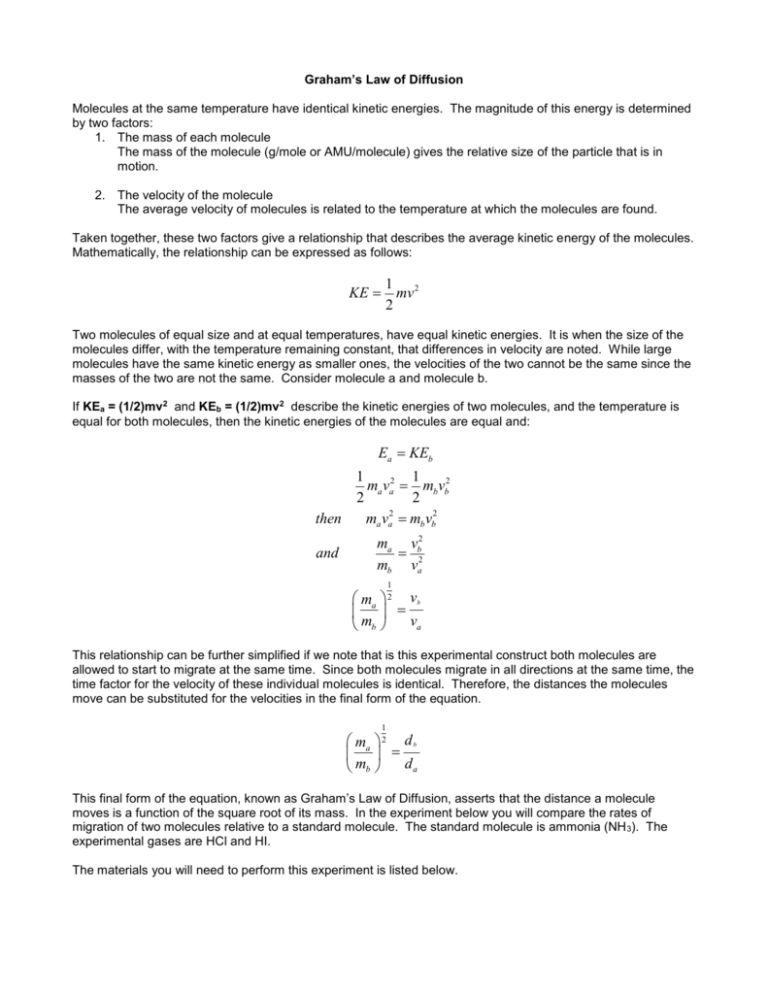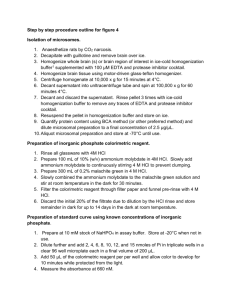Graham`s Law Lab
advertisement

Graham’s Law of Diffusion Molecules at the same temperature have identical kinetic energies. The magnitude of this energy is determined by two factors: 1. The mass of each molecule The mass of the molecule (g/mole or AMU/molecule) gives the relative size of the particle that is in motion. 2. The velocity of the molecule The average velocity of molecules is related to the temperature at which the molecules are found. Taken together, these two factors give a relationship that describes the average kinetic energy of the molecules. Mathematically, the relationship can be expressed as follows: KE 1 2 mv 2 Two molecules of equal size and at equal temperatures, have equal kinetic energies. It is when the size of the molecules differ, with the temperature remaining constant, that differences in velocity are noted. While large molecules have the same kinetic energy as smaller ones, the velocities of the two cannot be the same since the masses of the two are not the same. Consider molecule a and molecule b. If KEa = (1/2)mv2 and KEb = (1/2)mv2 describe the kinetic energies of two molecules, and the temperature is equal for both molecules, then the kinetic energies of the molecules are equal and: Ea KEb 1 1 ma va2 mb vb2 2 2 2 then ma va mb vb2 and ma vb2 mb va2 1 ma 2 vb va mb This relationship can be further simplified if we note that is this experimental construct both molecules are allowed to start to migrate at the same time. Since both molecules migrate in all directions at the same time, the time factor for the velocity of these individual molecules is identical. Therefore, the distances the molecules move can be substituted for the velocities in the final form of the equation. 1 ma 2 d b da mb This final form of the equation, known as Graham’s Law of Diffusion, asserts that the distance a molecule moves is a function of the square root of its mass. In the experiment below you will compare the rates of migration of two molecules relative to a standard molecule. The standard molecule is ammonia (NH 3). The experimental gases are HCl and HI. The materials you will need to perform this experiment is listed below. Chemicals 2 M HCl and household NH3 2M Sodium Iodide solution Universal Indicator Distilled water Hardware 96-well microplate microtip pipettes (4) plastic zip-lock bag Soda straws, 4 2-cm pieces Scissors Directions Part 1: Migration of HCl vs. NH3 1. Fill the wells of a clean microplate with distilled water from your small beaker. Be sure that all the wells are full. 2. Wipe off excess water from the top of the plate with a paper towel. 3. Place the microplate on a white piece of paper. Remove the water from well D1, D12, B3, G3, B10 and G10 with a pipette. Place a drop of universal indicator in each of the remaining wells (they already have water in them). 4. Cut four 2 cm pieces of plastic soda straw and place them in the wells B3, G3, B10 and G10. 5. Place the entire assembly into the plastic bag. Secure the seal. 6. Poke a hole in the bag above the wells numbered D1 and D12 (use the tip of a mechanical pencil). 7. Load two pipettes with approximately ½ mL of HCl and ½ mL of NH3, separately. The amount doesn’t have to be exact, but the stem (narrow part) of the pipette should be not more than ½ full. 8. Line up the pipettes so that the one containing HCl is directed into well D1 and the other is over well D12. 9. At the same moment, add 4-5 drops of the liquids to each of the wells. 10. Remove the pipettes and observe the pattern of color change as the gases of HCl and NH 3 migrate from their starting wells. 11. After no more change is apparent (~ 10-15 minutes), count the number of wells changed due to HCl, usually tinted red or yellow. Count the number of wells that were changed by the NH 3 tinted blue or violet. Record the number of wells changed for each gas in the Data Table below. Student Data Sheet—Graham’s Law of Diffusion Name Partners Block Date Data Table Number of wells changed by: HCl = wells NH3 = wells Calculations 1. Fill in the relative masses of the molecules, MM(HCl) = Molar Mass of HCl, MM(NH3) = Molar Mass of NH3. MM(HCl) MM(NH3) = _________ = Mass Ratio Mass Ratio (Theoretical ) = ___________ 2. Substitute the number of wells changed by each chemical in the same equation under the appropriate value of the distance, d. Mass Ratio (Experimental) = number of NH 3 wells number of HCl wells Questions 1. Which molecule migrated faster, HCl or NH3? How could you tell? 2. Do the theoretical and experimental mass ratios match? Explain. 3. An unexpected use of Graham’s Law of Diffusion can be found in the history of the development of the ATOMIC BOMB!!!! Find out how this physical law was used in the development of the first nuclear weapon. Cite your source!









